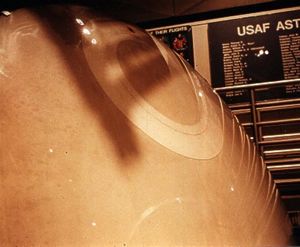
Home - Search - Browse - Alphabetic Index: 0- 1- 2- 3- 4- 5- 6- 7- 8- 9
A- B- C- D- E- F- G- H- I- J- K- L- M- N- O- P- Q- R- S- T- U- V- W- X- Y- Z
Gemini B RM
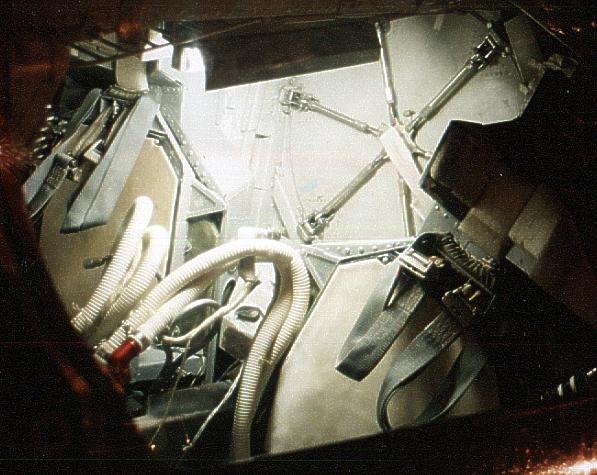
Gemini B Hatch
View of Gemini B hatch in heat shield, as seen from the interior. Compare it with the equivalent hatch in the Soviet TKS manned spacecraft.
Credit: © Peter Bednar
AKA: Reentry Module. Status: Cancelled 1969. Gross mass: 1,983 kg (4,371 lb). Unfuelled mass: 1,950 kg (4,290 lb). Specific impulse: 283 s. Height: 3.35 m (10.99 ft). Diameter: 2.32 m (7.61 ft).
Gemini B was not designed to fly separately, but rather was launched with the crew aboard attached to the manned orbiting laboratory. After reaching orbit, the crew would shut down the capsules systems and put them into hibernation. They would crawl through an 0.635 m diameter hatch in the heat shield, leading to a tunnel that accessed the MOL itself. After thirty days of operations, the crew would return to the Gemini B, separate from the MOL, and reenter the atmosphere. Gemini B had only 14 hours of 'loiter capability' for autonomous operations after separation from the MOL.
Many changes were made from the original NASA Gemini, including:
- Internal systems were containerized and designed for long term orbital storage
- The cockpit layout was completely redesigned and new instruments were developed
- The cant of the ejection seats were changed in order to make room for the hatch in the heat shield between the crew's shoulders
- After the Apollo fire, cabin atmosphere was changed to Helium-Oxygen in place of pure oxygen. At launch, the crew breathed pure oxygen in their suits while the cabin was filled with pure helium. During ascent, oxygen from the suits slowly brought the cabin atmosphere up to the helium-oxygen content of the station itself.
- In order to handle higher energy re-entries from polar orbit, the heat shield was increased in diameter, so that it actually stuck out a bit from the base of the re-entry vehicle.
- The OAMS maneuvering thrusters of the NASA Gemini were deleted. Spacecraft orientation in orbit was handled by the forward RCS thrusters.
Crew Size: 2. Orbital Storage: 40 days. Habitable Volume: 2.55 m3. Structure: 638 kg (1,406 lb). Heat shield: 144 kg (317 lb). Reaction Control System: 133 kg (293 lb). Recovery Equipment: 98 kg (216 lb). Navigation Equipment: 63 kg (138 lb). Telemetry Equipment: 51 kg (112 lb). Electrical Equipment: 126 kg (277 lb). Communications Systems: 26 kg (57 lb). Crew Seats and Provisions: 426 kg (939 lb). Crew: 144 kg (317 lb). Miscellaneous Contingency: 100 kg (220 lb). RCS Fine No x Thrust: 16 x 98 N. RCS specific impulse: 283 sec. RCS total impulse: 90 kgf-sec. Electric System: 4.00 kWh. Battery: 180.00 Ah.
Family: Manned spacecraft, Space station orbit. People: McDonnell. Country: USA. Spacecraft: MOL. Launch Vehicles: Titan. Propellants: N2O4/MMH. Agency: USAF. Bibliography: 137, 2174.
 | MOL Manned Orbiting Laboratory, Final Design Credit: © Mark Wade |
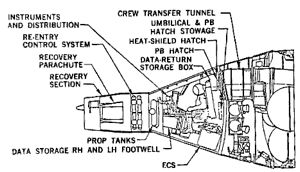 | Gemini B Gemini B cross-section Credit: McDonnell Douglas |
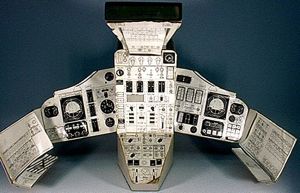 | Gemini B Panel Gemini B control panel, as would be used in the MOL project, showing numerous changes from NASA Gemini. Credit: Glen Swanson |
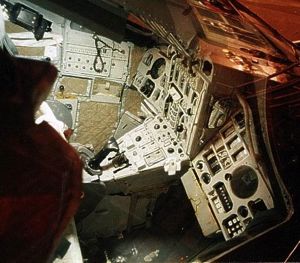 | Gemini B Interior View of Gemini B control panel. The panel differs substantially from that of NASA's Gemini spacecraft for the MOL mission. Credit: © Peter Bednar |
Back to top of page
Home - Search - Browse - Alphabetic Index: 0- 1- 2- 3- 4- 5- 6- 7- 8- 9
A- B- C- D- E- F- G- H- I- J- K- L- M- N- O- P- Q- R- S- T- U- V- W- X- Y- Z
© 1997-2019 Mark Wade - Contact
© / Conditions for Use
